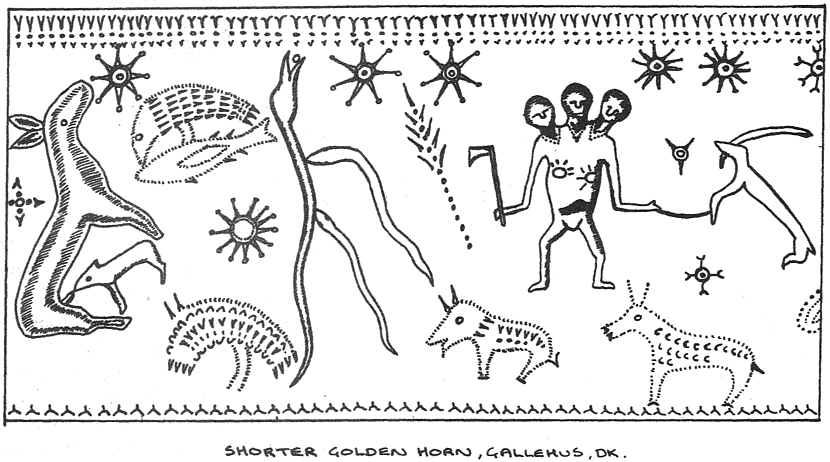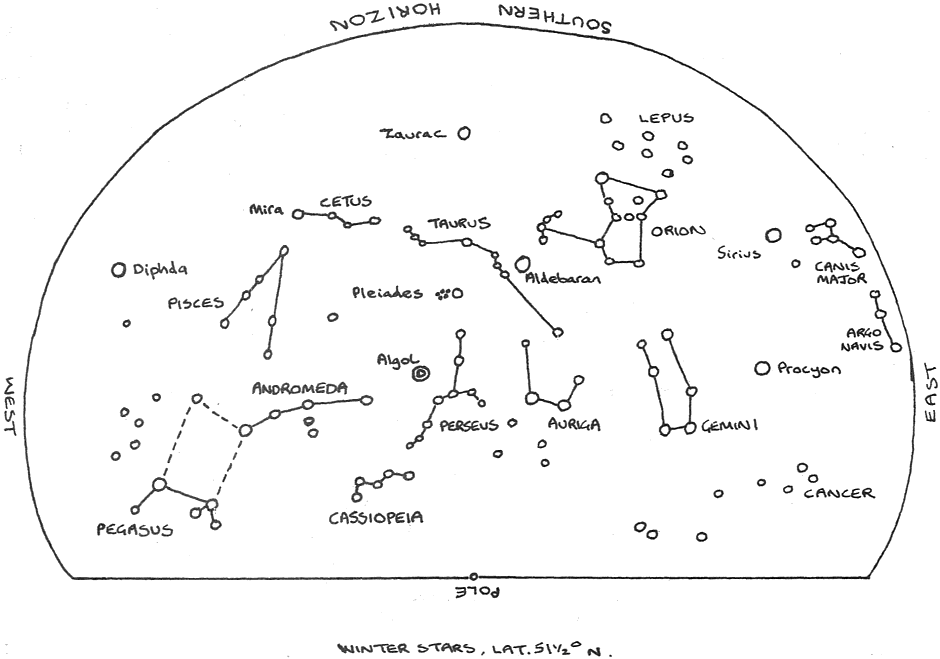
Ancient Mysteries no. 18, January 1981 (continuation of Journal of Geomancy)
{16}
{17}
The IGR has recently shown (Journal of Geomancy vol. 4 no. 1) that the ‘barbarian’ peoples of early Europe maintained a body of astronomical lore that was independent of Mediterranean science. Reuter’s reconstructed star-maps and occasional references in Scandinavian literature together indicate that the constellations were observed, recognized, charted and mythologized in northwestern Europe in the first millennium CE, but at present there is little evidence for similar activities in earlier ages. It is, however, possible that whatever evidence does exist has been overlooked or misinterpreted.
I should like to draw attention to a piece of decorated metalwork, discovered at Gallehus in Denmark and apparently dating from the Iron Age, which strongly suggests that astronomy was not neglected by the Celto-Teutonic peoples of that period. Part of this object, the ‘shorter golden horn’, is given as an illustration of the ‘cult of the head’ in Dr Anne Ross’s work Pagan Celtic Britain. Dr Ross there commented that “the symbolism of this unique object is obscure”, a statement which is open to serious doubt.

The ‘unique object’ is pictured in the first figure, and its ‘obscure’ symbolism will be seen to include a three-headed axe-man, a number of stylized creatures and some radiate objects which suggest stars. In the upper left portion there appears a fish linked to another beast – possibly a bird but more likely a second fish; if these creatures are taken to represent the constellation Pisces (which is shown in Classical zodiacs as a pair of linked fish), the other symbols may be identified as representing the major constellations and notable stars visible on winter nights.

A simplified map of the winter constellations is shown in the second figure, as nearly as possible at the same scale, to facilitate comparisons. Reading from left to right, the identifications are these:
The large animal on the extreme left, apparently a horse, represents the stars now known as Pegasus (the winged horse); the large stellar object by the horse’s head seems to be the star Diphda in Cetus; the fourfold pattern behind the horse’s back may be the bright southern star Fomalhaut, or might just represent the vernal equinoctial point.
The smaller animal between the horse’s legs, probably a foal, stands for the constellation Andromeda.
Pisces has been identified above; the star pictured below the fish is Algol in Perseus, a binary system known as the “winking Demon” because of the periodic eclipse of its brighter member by the other.
The odd, crescent-shaped creature below Algol represents the constellation Cassiopeia, now recognized by the W-formation of its five most prominent stars.
The three serpents occupy that part of the heavens now given to the constellations Perseus, Taurus and Cetus; it is possible that the two lesser serpents are meant to indicate the clusters now called the Pleiades and Hyades, both in Taurus; the small circle, between the jaws of the larger serpent is the long-term variable star Mira in Cetus, which is periodically ‘swallowed’ as its brightness falls to ninth magnitude in a 331-day cycle.
To the right of the serpents, the object resembling a corn-spike is in the place of the prominent red star Aldebaran; the two stars above it stand for the scattered constellation Eridanus.{18}
The axeman is most clearly Orion, the axe standing for the hunter’s bow; his three heads are marked by the stars of the constellation Lepus; on his body, two circles mark the bright star Rigel and its neighbour Saiph, while a dark patch seems to indicate the three stars of the belt.
The creature on the extreme right, which the axeman holds on a lead, is the hunter’s dog now called Canis Major (its hindquarters now assigned to the southern constellation Argo); between the two figures, a double circle with three ‘ears’ marks the bright Dog Star, Sirius; below this, another circle with four extensions represents the major star Procyon in Canis Minor (the stars at the upper right edge of the diagram defy particular identification).
Finally the two creatures below the axeman, perhaps meant as boars, are the constellations Auriga and Gemini, their eyes being respectively the bright stars Capella and Castor; the creature on the right would seem to extend from Gemini into the stars of Cancer.
The relative placings of the various symbols are tolerably accurate if they are meant to represent the winter constellations, as claimed above. Particularly striking are the separate features which stand for identifiable or remarkable single stars: Sirius, Procyon, Algol, Mira and (perhaps) Aldebaran. If the general identification is correct, the existence of the ‘shorter golden horn’ points to an evolved and comprehensive knowledge of the heavens in an Iron Age context – but it would be surprising if such a knowledge did not exist.
Two further comments are necessary. First, the star-map is inverted; its upper edge represents the horizon, its lower edge the zenith; this might be thought to detract from the likelihood of the argument, for it implies an unusual perspective for the night sky. Second, the map is incomplete: one would expect to find a companion diagram for the summer stars between Leo and Aquarius; perhaps such a thing exists, but I have not seen an illustration of it. I would welcome criticism of the argument offered here as well as any information on the date and cultural provenance of the Gallehus Horn.